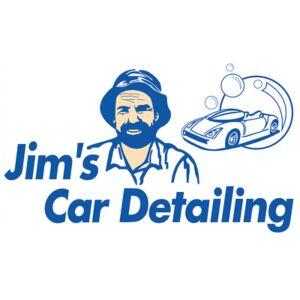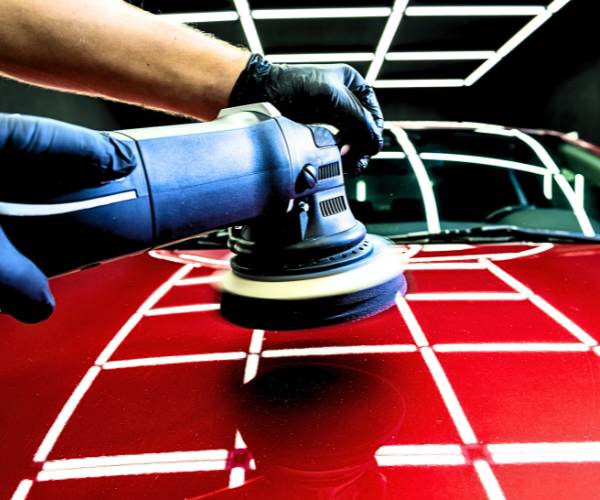Includes FREE 1 Year Paint Protection Valued At $149
Exterior Inclusions
Pre-rinse vehicle
Bug splash & road tar removed (if any)
Wheels, tyres & arches cleaned
Door & boot jambs pressure cleaned & dried
Fuel door pressure cleaned & dried
Snow foam hand car wash & dry
Paint decontamination treatment
Cut & polish for reduction of swirl marks/scratches & gloss enhancement
Rubbers & plastics glossed
Windows & mirrors cleaned
Tyres, wheel arches & mud flaps glossed
WHAT IS CUT & POLISHING?
With many years of experience in the car detailing industry, Jim’s Car Detailing franchisees have mastered the art of cut and polish to give your vehicle the shine it deserves. The ultimate shine requires polishing in some form to your paint. No wax in the world will improve the appearance of a paint surface as well as cut and polishing.
Cut and Polish is a process where an extremely fine layer of clear coat is removed using specific cutting and polishing compounds. This flattens the surface of your vehicle’s paint work, permanently removing fine swirls and scratches in your clear coat which appear when looking at your paint in direct sunlight. These scratches are most visible on darker coloured cars.
A vehicle paint that is cut and polished by the experts in Jim’s will result in high levels of shine and gloss. Your vehicles paint is prepared for cut and polish through a thorough hand wash with our biodegradable pH neutral shampoo followed by a clay bar treatment to remove oxidation, industrial fallout, rail dust and brake dust. It is then buffed with the highest quality cutting compounds to remove swirls and light scratches.
Cut and polish process on most paint surfaces require at least a two-step process. The defect-removing step followed by a finishing step. Many Japanese and Australian made vehicles have soft clear coats, which make them easier to remove defects, requiring less aggressive methods to perfect.
Many European car manufacturers in recent years have started adding ceramic particles into their clear coats to make them scratch-resistant. These ceramic clear coats require the best compounds on the market to effectively correct these extremely hard surfaces. Luckily Jim’s Car Detailing professionals have the right compounds and polishes for these kinds of vehicles.
Most car detailing shops or mobile detailers in Australia do not use the right products to cut and polish your vehicle or don’t have enough experience in the field. They will go ahead and use an aggressive cutting compound (a liquid designed to flatten clear coat quickly) and an aggressive wool pad at dangerously high speeds on a very powerful rotary buffer/polisher, which can easily remove the clear coat and burn the paint of your vehicle in seconds in the wrong hands. Machine buffing requires experience and patience, or high levels of damage can easily occur.
When cut and polishing, it is extremely important to use the right compounds and polishes with the right pads and machines along with the right technique to achieve the perfect finish. Misuse of even a single one of them can cause irreversible damage to your vehicle resulting in a respray job. It is vital to apply that perfect pressure on the cutting machine to give the pad that perfect heat. Experts at Jim’s Car Detailing have many years of experience in the field so rest assured that we will give your vehicle the love it needs.
Unfortunately most car detailers skip the crucial refining steps of cut and polish which results in an uneven surface, leaving new set of swirls in the paint. Instead, after the compounding steps on the rotary buffer at dangerously high speeds, the detailing shop will “glaze” the paint. A glaze is an oil-rich liquid that will temporarily hide and fill-in most of the defects in your paint or clear coat, especially swirls and fine scratches. After a few rain showers, the glaze will rinse away, resulting in a paint surface that looks worse than what it was prior to cut and polishing. We don’t use fillers to fill in the scratches – we remove them!
Yes, even new cars that are close to 100% defect free can benefit from a very fine polishing of the paint surface. After prepping the paint for cut and polish, a fine machine polish will burnish the paint like a diamond to microscopically refine the surface to an extreme flatness, resulting in the most optical clarity and reflectivity. Polishing the paint with a fine polish will significantly improve the gloss and wet-look of a painted surface, and that’s before any wax has been applied to the paint surface! For the fanatical car enthusiast, performing the ultra-fine polishing step multiple times will result in finish that is truly show worthy. With each and every pass of our ultra-fine polishing process, the finish will get wetter, and the reflections will get deeper.
QUESTIONS & ANSWERS
What is a cut and polish?
A cut and polish is a commonly used expression that refers to reducing the appearance of scratches & marks on the paintwork (the “cut”), whilst “Polish” is about restoring gloss to the paint.
Can I cut and polish by hand?
While you can do a cut and polish by hand, it is very time consuming, and often gives an inconsistent finish. You will get a much better result by using a professional grade buffer and cutting compounds, such as those used by Jim’s Car Detailing.
Will cut and polish damage my paint?
The cutting will remove a very small layer of clear coat, this is how the appearance of scratches are reduced. When followed with a polish, the gloss of the paintwork will be restored. However, if done by an inexperienced detailer, you can expect a thick layer of clear being removed, and in some cases burning of paintwork which will result in a respray job.
How often should I cut and polish my car?
If your car does not have a paint protection system applied, then ideally your car should be cut and polished roughly every 12 months, with regular maintenance washes in between.
Will a cut and polish remove scratches?
A cut and polish will reduce the appearance of scratches and surface marks on your paintwork by removing a very small layer of clear coat, and when followed by a polish the paint work will have a glossy appearance.
Do you need to wax after a cut and polish?
During a “cut” of a cut and polish all residual wax or sealant is removed from the paint work along with a very small layer of clear coat, leaving you with bare unprotected paint. Applying a polish, sealant or ceramic coating protects the paint work and preserves the finish and adds longevity to your cars paint.
Should you cut and polish a new car?
Yes! New cars are typically covered in a vinyl wrap during shipping. Dealers then remove the wrap and apply a glaze to the paintwork to hide surface marks, often caused by improper washing at the dealer, this glaze quickly washes away leaving you with marked paint. A cut and polish will remove these marks restoring the new paintwork.
Is polishing the same as buffing?
These terms are somewhat interchangeable, and they both refer to refining the finish of your cars paint work.
Should I wax my car?
Yes, regular application of a wax, sealant, or ceramic coating will act as a sacrificial barrier and protect your paint work from chemical fallout, tree sap and bird droppings.





